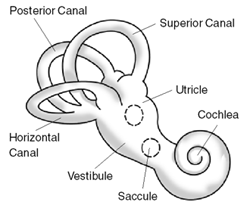BPPV
| Benign paroxysmal positional vertigo | |
|---|---|
 |
|
| Exterior of labyrinth of the inner ear. | |
| Classification and external resources | |
| Specialty | Otorhinolaryngology |
| ICD-10 | H81.1 |
| ICD-9-CM | 386.11 |
| OMIM | 193007 |
| DiseasesDB | 1344 |
| MedlinePlus | 001420 |
| eMedicine | ent/761 emerg/57 neuro/411 |
| Patient UK | Benign paroxysmal positional vertigo |
| MeSH | D014717 |
Benign paroxysmal positional vertigo (BPPV) is a disorder arising from a problem in the inner ear. Symptoms are repeated, brief periods of vertigo with movement, that is, of a spinning sensation upon changes in the position of the head. This can occur with turning in bed or changing position. Each episode of vertigo typically lasts less than one minute.Nausea is commonly associated. BPPV is one of the most common causes of vertigo.
BPPV can result from a head injury or simply occur among those who are older. A specific cause is often not found. The underlying mechanism involves a small calcified otolith moving around loose in the inner ear. It is a type of balance disorder along with labyrinthitis and Ménière's disease. Diagnosis is typically made when the Dix-Hallpike maneuver results in nystagmus (a specific movement pattern of the eyes) and other possible causes have been ruled out. In typical cases medical imaging is not needed.
BPPV is often treated with a number of simple movements such as the Epley maneuver or Brandt-Daroff exercises. Medications may be used to help with nausea. There is tentative evidence that betahistine may help with the vertigo but its use is not generally needed. BPPV is not a serious condition. Typically it resolves in one to two weeks. It however may recur in some people.
The first medical description of the condition occurred in 1921 by Robert Barany. About 2.4% of people are affected at some point in time. Among those who live until their 80s, 10% have been affected. BPPV affects females twice as often as males. Onset is typically in the person's 50s to 70s.
Many patients will report a history of vertigo as a result of fast head movements. Many patients are also capable of describing the exact head movements that provoke their vertigo. Purely horizontal nystagmus and symptoms of vertigo lasting more than one minute can also indicate BPPV occurring in the horizontal semicircular canal.
...
Wikipedia
